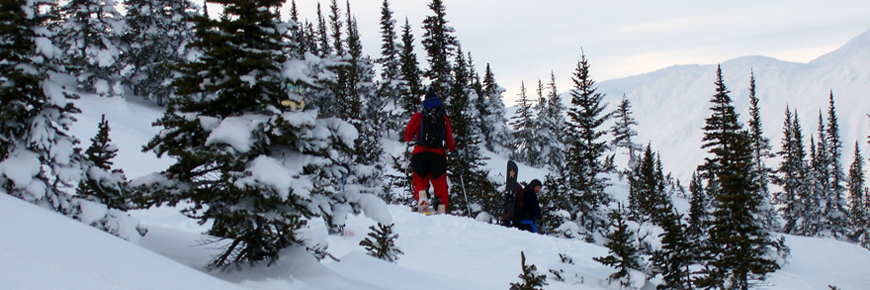
Winter backcountry safety
Chilkoot Trail National Historic Site
The Chilkoot Trail and White Pass area is remote. Your safety is your personal responsibility. While natural hazards exist, the risks can be minimized by taking reasonable precautions. Careful pre-trip planning, appropriate equipment and knowledge of natural hazards are all essential. Choose a trip that reflects the level of ability of your group.
Avalanche hazard | Weather | Lake ice | Exposure | Be prepared | Emergency contact information
Avalanche hazard
Significant avalanche terrain exists in the Chilkoot Trail and White Pass area. All winter backcountry users should know how to recognize and avoid avalanche terrain.
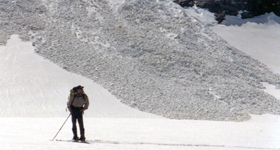
Travel through avalanche terrain requires a special set of skills for evaluating avalanche risk. While in avalanche terrain, your entire group must be properly equipped with shovels, avalanche transceivers and probes, so as to be able to find and rescue a member(s) of your party should they get caught in an avalanche.
More information on avalanche safety.
Weather
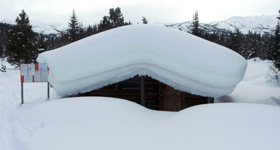
Weather in the Chilkoot/White Pass area can be extreme and unpredictable. Even if the day starts out sunny, be prepared for cold temperatures, snow, strong winds and poor visibility. Whiteout conditions can complicate route-finding and prevent you from detecting avalanche terrain, open water and overflow. Road closures are common due to high winds and driving snow. Weather can also play a major role in the development of avalanche hazard.
It is important to check current weather conditions and forecasts when planning a trip to the Chilkoot Trail / White Pass area. The Yukon Avalanche Association website has a comprehensive listing of weather resources (current conditions, forecasts, webcams) for the area.
Lake ice
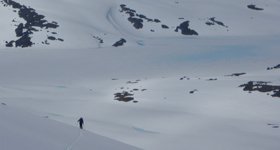
You may encounter water (overflow) under the snow layer on any of the lakes, rivers or creeks in the area. This slush layer may also be present around underground springs. Thin ice may be encountered on any water body (generally in spring and early winter and also near inflows and outflows of lakes). If you become wet, you must be prepared to dry out your gear, or carry dry gear to change into. Extreme caution should be exercised when travelling on lakes and streams.
Exposure
Hypothermia
Hypothermia is the lowering of the interior body temperature, and is caused by exposure to the cold, aggravated by wetness, wind and personal exhaustion. Your body is similar to a furnace: if it loses more heat than it can produce, the body's core temperature will drop. Without an external heat source hypothermia can be fatal.
Watch for these symptoms:
- uncontrollable fits of shivering
- slurred speech
- stumbling
- loss of coordination: difficulty performing simple tasks
- changes in normal behaviour: a good-natured person may begin to grumble and complain.
Frostbite
Frostbite is the actual freezing of the body tissues caused by exposure to cold, especially when aggravated by wind and wetness. The nose, ears, cheeks and chin are most often affected, but more severe cases of frostbite can involve the hands and feet.
Watch for these symptoms:
- affected area becomes cold and numb
- skin turns white, yellow-white and/or mottled blue-white
Be prepared
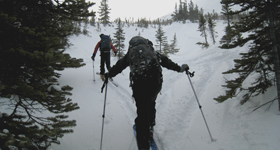
To ensure you have a safe and enjoyable trip, please plan your trip carefully. Do not attempt activities beyond your skills and capabilities, and use your discretion when traveling in the backcountry. You are ultimately responsible for your own safety.
A few tips:
- It is always safer to travel in a group
- Pick an objective that is within your group’s ability and have an alternate plan in case conditions change.
- Check the weather forecast.
- Let someone know your plans. Leave an itinerary, route map and the names of your party with a friend or family member.
- Ensure that you are properly equipped.
- Take your avalanche safety gear and know how to use it if you are venturing into avalanche terrain.
- Dress in layers to adapt to changing conditions
- Drink and eat regularly to stay hydrated and maintain energy
- Set a turn-around time and stick to it.
NOTE: Except in an emergency, open fires are not permitted in the park. Backpacking stoves or woodstoves in the shelters at Lindeman are your only source of heat on the Canadian side of the trail.
Emergencies
Chilkoot Trail National Historic Site is a remote wilderness park. Travellers must be entirely self-sufficient and able to handle any emergency situations on their own. In the event of an emergency you should be prepared for lengthy delays in search and rescue response times due to weather conditions and/or the availability of both aircraft and rescue personnel.
There is no cell phone coverage in Chilkoot Trail National Historic Site. We recommend you carry a satellite communications device. Be aware that coverage can be adversely affected by vegetation and topography in some locations.
The closest telephone is at Canada Customs at Fraser on the South Klondike Highway (6.5 km/4 miles south of Log Cabin parking lot). Let the dispatcher know that you are in the Chilkoot Trail National Historic Site, and then give your precise location and the accident details.
Parks Canada 24 hour emergency dispatch
Via satellite phone or telephone: 1-780-852-3100
Via satellite messaging device: Use the SOS function in the event of an emergency, and your service provider will connect Parks Canada Emergency Dispatch to you.
RCMP Carcross
1-867-821-5555
Related links
- Date modified :
